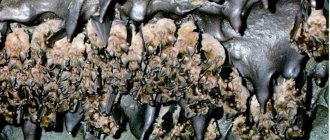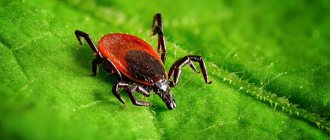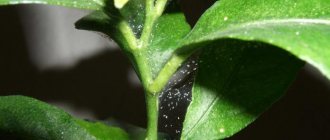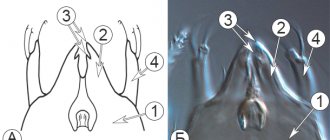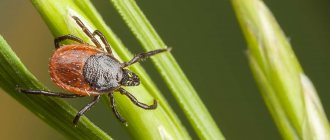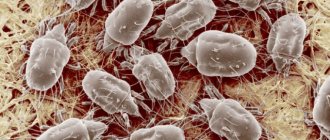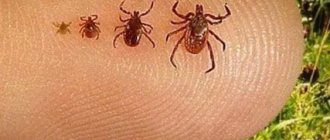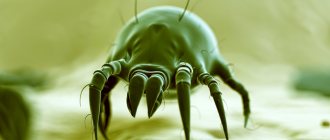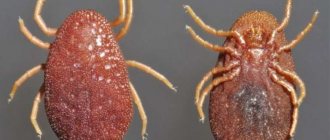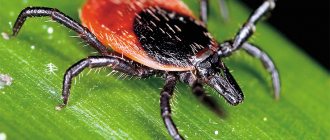Are ticks dangerous for humans in winter?
In most regions of Russia, ticks are not active in winter, and encounters with them can only occur in exceptional circumstances.
Most often this happens when a tick enters the house in the summer - on clothing or some objects. Sometimes victims of winter bites bring ticks from foreign trips to warm countries. Since the most dangerous viruses and bacteria are carried by these mites, it is simply necessary to send the parasite for laboratory analysis in this case.
Under unfavorable conditions, ticks disappear, going into hibernation with the onset of cold weather. Thus, the danger of being bitten by a tick in winter in central Russia is practically zero.
About precautions
Natalya Shashina argues that some precautions should be taken to avoid picking up a tick. “Mushroom pickers walk through the forest for a long time and can easily bring a tick. But they are not the only ones at risk: it is also vacationers, tourists and all those who walk through the forest without observing preventive measures. Basic rule: ticks wait for their victims on blades of grass, they attack immediately, then move from the lower leg to the top. Their target is the skin under clothing. They are suctioned in those areas where there are folds: in the groin, armpits and even in the area of the shoulder blade, where clothing fits tightly to the body. Ticks sometimes attach themselves near the eyes on the face. Therefore, when going into the forest, you need to wear long trousers and tuck them into socks with elastic bands or boots. The tick will begin to crawl upward and will not be able to get under the trousers,” says the expert.
Winter activity of forest ticks in different climatic zones
Resistance to cold in different types of ticks depends on the area of their permanent habitat. In Russia, the northernmost region where these parasites live is the coast of the Barents Sea. Populations living in this area often cannot find food for themselves throughout the summer and hibernate again.
In Siberia, the distribution and survival of ticks are associated with the stability of the snow cover and the level of thermal insulation of the forest floor.
In central Russia, ticks choose for wintering areas with secondary forest plantations and edges with dense bushes.
In the south of the country, parasites hibernate for only a short time, using the burrows of small vertebrates or voids underground.
Winter activity
A decrease in air temperature always negatively affects the activity of parasites, since they are not able to maintain a constant body temperature. A signal for hibernation is also a reduction in daylight hours and a change in relative air humidity.
Under unfavorable external factors, parasites enter a special state - diapause, which allows them to safely survive the winter. In central Russia, the seasonal activity of parasites ends at the end of October.
Interestingly, hungry individuals of all developmental phases turn out to be more resistant to negative temperatures. In well-fed ticks, cold resistance is reduced due to processes associated with metamorphosis and molting after feeding on blood. Females engorged with blood are unable to control their reproductive processes, and their eggs, not having sufficient cold resistance, usually die by 99%.
In the spring, hibernating ticks wake up. In mid-latitudes, adult individuals become active already at a temperature of +3... + 50C, showing the greatest activity in places well warmed by the sun's rays.
Fighting techniques
You can scare away parasites with the help of a strong smell - this could be the essential oil of citronella, lavender, or cloves.
Speaking of special products, you can buy sprays and aerosols, the most effective of which are:
- Gardex;
- Reftamide Anti-mite;
- Raptor;
- Raid;
- Taiga;
- Off;
- Moskitol.
You need to spray your clothes thoroughly with them; several of them are suitable for treating leather.
In order to save a plot of land from pests, as well as to maximize the safety of outdoor recreation, smoke bombs are used:
- Quiet evening;
- Vortex;
- Fomorian
There are also solutions (based on insectoacaricides) intended for treating grass and trees:
- Digital;
- Sinuzan;
- Executioner;
- Medilis-Ziper;
- Forsyth.
Mass poisoning of ticks is not carried out, as the chances of harming birds, animals, and insects (natural enemies) increase - this is the reason why there are so many ticks.
After using chemicals, the parasites disappear, but natural enemies also disappear, and the population of parasites becomes larger, but their destroyers do not. That’s why many people talk about the emergence of a situation where previously there were several ticks, but now they have filled the entire area.
Individuals become active around the end of March and end their activities in November. Of course, you need to take care of safety, but there is no need to panic. Not all parasites are contagious, and if you consult a specialist in a timely manner, the risk of disease is minimized or the disease proceeds without any problems.
You need to think in advance about the availability of clothing and medications; it is also recommended to get vaccinated if you plan to visit a dangerous territory or area.
Peculiarities of wintering of ticks at different life stages
The life cycle of ixodid ticks consists of several phases: eggs, larvae, nymphs, adults. With rare exceptions, they all go through the wintering stage.
Hungry females are most resistant to cold. They can stay at sub-zero temperatures for a long time without harm to vital functions. Fed larvae are most vulnerable. They die after 3-5 days if the thermometer drops to -7...-10 degrees below zero. Hungry larvae and engorged nymphs cope with sub-zero temperatures more confidently.
The female dies in the fall while laying eggs, which continue to remain in her body and only emerge in the spring as larvae. The larva is already ready to feed on the blood of animals and people. During this period, she transforms into a nymph, after which she falls into hibernation. In spring the nymph is active again. Having had enough, it hibernates again, only to turn into an adult insect after waking up.
After another wintering, fertilized females complete their life cycle by laying eggs. Males die after completing the fertilization mission.
Eggs
Natural factors that have a negative impact on the survival of parasites in the cold season
The most common cause of death of the forest tick population is early November frosts, when the thickness of the snow cover is minimal or absent altogether.
On a note
Snowless winters reduce the number of ticks in a natural focus by 60-70%. It takes 2-3 years to restore the population to its previous level (under favorable climatic conditions).
Areas of meadows covered with short grassy vegetation do not provide reliable thermal insulation of places where ticks overwinter, so with the onset of cold weather, pasture ixodids penetrate deep into soil cracks and rodent burrows.
Excessive soil moisture significantly worsens the thermal insulation properties of tick habitats. Heavy autumn rainfalls followed by frosts often lead to hypothermia and death of parasites.
But the greatest natural danger for wintering parasites is thaws with complete snowmelt and subsequent frosts. Such phenomena cause a significant decrease in the thickness of the snow cover and freezing of the soil to great depths.
Where do ticks hide in winter?
It is also interesting how the tick overwinters. The parasite remains at the stage of development at which it was in the fall.
Ticks choose for wintering places where snow lies for a long time and is not blown away by the wind. They hide in leaves and grass, where the temperature does not drop to sub-zero levels. During decomposition, the remains of vegetation release a certain amount of thermal energy, providing the necessary conditions for overwintering of ticks.
In winters with little snow, up to 20-25% of overwintering ticks die in nature.
What Natalya Shashina says
In September it is still quite warm, and many Russians go to the forest for a walk, pick mushrooms or go hiking. But ticks can become unpleasant companions for lovers of “quiet hunting” or ordinary tourists. “Around mid-August, the 2nd increase in tick activity begins. These are mainly ticks of the genus Ixodes, which carry the same ailments as in the spring: borreliosis and encephalitis - as well as Dermacentor, which are mainly dangerous for dogs. Mites become active at 9 °C. The end of their activities depends on the weather: if warm weather continues, the danger may remain until December. If there is a short cold spell, the ticks do not die, and are revived again at the next warming,” says the expert.
Optimal conditions for wintering ixodid ticks
When discussing how ixodid ticks winter, it should be noted that the optimal temperature for their wintering is about zero degrees. This also requires a sufficiently high air humidity. In the conditions of central Russia, their survival is possible only with stable snow cover.
Ticks can spend the winter well in the burrows of small rodents, sometimes managing not to even go into diapause and continuing their active lifestyle, parasitizing the hosts that shelter them. Often in the spring such mites still live on these vertebrates.
Which territories of the Russian Federation are safe in autumn?
The scientist claims that in the fall, unlike in the spring, ticks do not become active in all regions of the Russian Federation. “In autumn, the number of ticks is lower, so this time of year is less dangerous. The second peak also does not affect the Far East, the Urals and Siberia. Other ticks live there and sleep in the fall. There are isolated cases when they infect a person, but this is a rare occurrence. But in the European zone this is a real problem. The reason is the development cycle of mites. Arachnids become active in the second half of summer and try to feed immediately,” said Natalya Shashina.
Spring Solstice (March 21): In the old days, people took knives to drive away troubles
The animated series "Peppa Pig" will last until 2027, 104 new episodes will be filmed
Is the decision to introduce the Internet to all schools in Russia safe: the minister’s answer
How to clean a Christmas tree from beetles, spiders and ticks?
In the central zone of Russia, the weather is now relatively warm for winter, Euro-winter, so when placing a live spruce tree at room temperature, aphids, beetles and other insects will perceive this as the onset of spring.
You may not believe that mites can live in a Christmas tree, but before installing it in the living room, shake it thoroughly over the bathtub and see how many small bugs and their larvae fall off it. It’s better to keep the spruce tree in the bathroom for several hours so that insects coming out of hibernation cannot scatter around the house.
Second tip: strip the bark from the lower part of the tree trunk; it is advisable to do this outdoors, or in a bathtub. When outside, give the tree a good shake.
It doesn't hurt to be careful. You should not treat spruce with such strong-smelling insecticides as Dichlorvos or the like.
Such a scent will ruin the entire festive mood, and the plant will dry out ahead of time.
You should not treat spruce with such strong-smelling insecticides as Dichlorvos or the like. Such a scent will ruin the entire festive mood, and the plant will dry out ahead of time.
The previously mentioned scientist, Bjarte Jordahl, said:
Clinical picture of allergy to household dust
An allergic reaction to dust is a rare occurrence. This reaction occurs only in predisposed individuals and is no different from allergies to food or cosmetics. Symptoms of a dust mite allergy on the skin:
- Severe itching that occurs immediately after or some time after contact with the contaminated surface. Itching can be localized in one area of the body or be generalized.
- Redness and rash. An itchy rash usually appears on the skin at the point of contact, rising above the surface of the body. Elements of the rash tend to merge to form giant lesions. After taking an antihistamine or on its own after some time, the rash involution occurs without residual effects (pigmentation, scars, etc.).
- Scratching. Appear due to intense scratching of the skin during itching. Pathogenic microorganisms can penetrate wounds, which leads to suppuration and deterioration of the condition.
- Conjunctivitis. There is a sensation of a foreign body in the eyes, photophobia, and lacrimation. Allergic conjunctivitis quickly turns into bacterial conjunctivitis, which is dangerous due to the development of complications (keratitis, uveitis and others).
Attacks of bronchial asthma due to allergies to household dust are seasonal: the process usually worsens in the spring and autumn months, at night. The attack of suffocation is protracted; the frequency and duration of attacks decrease when changing housing or regular wet cleaning.
Brief recommendations for dog owners:
1. If warm days suddenly arrive in winter, a thaw begins, and in some places soil and last year’s grass appear from under the snow, this means that the dog must be examined after a walk.
2. Try not to walk your dog near heating mains. Strictly exclude your pet from interacting with stray dogs.
3. Do not forget to regularly examine street dogs that live in kennels and enclosures. Especially during warming periods.
4. In spring-summer-autumn it is necessary to regularly carry out anti-tick treatment for your dogs. In the winter season, it would be a good idea to have a “standby” anti-tick spray that can be used before a walk when there is short-term warming outside (at the time of above-zero temperatures).
I have already written about my negative attitude towards the drug Bravecto, which is popular today, on the pages of Dog-Blog, you can read it at this link. I am very grateful to our readers who leave their comments under this material!
I am a supporter of more gentle and safe means for treating dogs against ticks. Which ones exactly, read in this material, where I list the most reliable, in my opinion, drugs.
What does a tit eat in the spring-summer season?
In terms of gluttony and omnivorousness, tits are comparable only to crows and pigeons. In urban areas, they can be found in trash cans, where they pick at bones, milk cartons and potato peelings. But their most obvious benefit is in the garden; they are inveterate enemies of pests and, accordingly, gardeners’ best friends. A pair of tits, when raising offspring, can save up to 40 trees from attack by the most dangerous pests. When feeding chicks, they have to make about 600 trips in search of food.
Where tits have settled, crop moth damage is very rare. They also eat hairy gypsy moth caterpillars, hawthorns, and many others that other birds avoid. They eat from morning until evening, and if they can no longer eat, they still kill the insect that catches their eye and hide it. And during periods of food shortage, they search for their bins and eat up supplies.
Recipes from the people
Despite the effectiveness of chemicals, many gardeners and summer residents prefer to use folk remedies for spider mites, the main advantages of which are safety and accessibility.
Decoctions and infusions
Herbal decoctions and infusions are widely used in pest control.
- Garlic (2 heads) is finely chopped, poured with water (1 liter), and left for 5 days in a dark place. The resulting infusion is filtered, the same amount of water is added and used to spray infected plants.
- It is good to remove parasites with mustard, the smell of which spider mites really do not like. 60 g of dry powder are diluted in 1 liter of water and infused for 3 days.
- Onion peel (100 g) is filled with water (5 l), infused for 5 days. After which the infusion is filtered and used to treat plants affected by mites.
- Dry or fresh alder leaves (200 g) are poured into 2 liters of water and boiled over low heat for 30 minutes. After which the broth is infused for 12 hours, filtered and used for spraying.
- Dandelion leaves and roots (100 g) are poured with hot water (1 l) and left to infuse for 3 hours. The strained infusion is used in the same way.
A soap solution (20 g of soap per 1 liter of water) gives an effective effect in the fight against spider mites. It is better to use regular laundry or green soap to prepare the solution. It is necessary to wash the leaves on both sides with a cloth soaked in soapy water, avoiding contact of the composition with the roots of the plant.
To spray flowers and garden plants, you can also use sulfur-tar soap (100 g of soap per 10 liters of water). The procedure is carried out 2-3 times a week.
I think that poison for treating garden crops is not the best option. I periodically use soap and garlic solution. In the early stages of plant infection, nothing better is needed.
Hydrogen peroxide and potassium permanganate
To combat spider mites at home, use a solution of hydrogen peroxide, which is prepared at the rate of 2 tbsp. l. (3%) product per 1 liter of water. Spraying is carried out once a week for a month, which allows you to destroy the entire harmful family over time. To treat the soil, use a weak solution of potassium permanganate.
Ammonia
Ammonia has similar properties. The solution is prepared in a ratio of 1 tbsp. l. for 10 liters of water. The resulting composition is used to treat the leaves on both sides, which will not only remove mites, but also saturate the plant with nitrogen.
Spider mites are afraid of cold water. It is necessary to put the plants under a cold shower every day for a week and the parasites will no longer disturb them.
Regular inspection of them and adherence to the rules of caring for them will help prevent the spread of pests on indoor flowers or seedlings: regular watering, timely weeding and fertilizing of plants, as well as the use of folk remedies for preventive purposes.
Now has come that time of year when even a tick can easily be “inflated” into an apartment by the wind from an open window. Those who have trees near their windows/balconies are especially susceptible to this. Also, ticks can be “airborne” from neighbors above, because they are so light that they are carried by the wind like specks of dust. They can be brought in with a newly purchased plant, if it is not first quarantined.
The biggest problem is fighting the tick, so, of course, it is better to prevent this matter.
I haven’t had any problems with mites for several years, since we moved to a new apartment, but this year I discovered a cobweb on the rose, and upon a detailed examination of the plants next to it, I also noticed disgusting living creatures.
Will wasps return to a hive under a roof in the spring?
After winter, the female wasps wake up. This happens when the air warms up to +15 degrees. Now they need to find a home for the warm season in order to place their offspring in it. Their appearance will not be noticeable immediately. At first, the wasps will set up their home and actively reproduce. And by mid-summer you can observe a full hive of young individuals.
Natural instinct calls the females to return to their native land. Therefore, if you do not destroy the houses of striped insects in the winter while they are empty, then in the spring a new family will settle there. How to effectively destroy a wasp nest:
- remove and throw away away from home;
- burn;
- treat with Dichlorvos or boric acid;
- sprinkle with bleach or a special repellent compound (“Raptor”, “Get”, “Alatar”).
Important: even if the nest was physically destroyed, the place where it was located must also be treated with a chemical composition. Otherwise, wasps can simply build a new home in place of the old one in their familiar territory
You can help move the swarm to a new location, away from people. For this purpose, comfortable areas are created, protected from bright light, wind and moisture. You can lure them with sweet fruits and water with sugar.
It was not for nothing that the wasp appeared in nature. At first glance, these insects are of absolutely no use, but rather the opposite. But in fact, striped ones destroy clouds of pests in the garden in order to feed their offspring. They also promote the reproduction of flowers and plants and carry pollen. And if you do not anger them and do not interfere with the period of conception of offspring, then wasps can exist peacefully next to humans. The life cycle is short, but they accomplish a lot in a year. Until the last days, they help the offspring survive so that the food chain is not disrupted.
